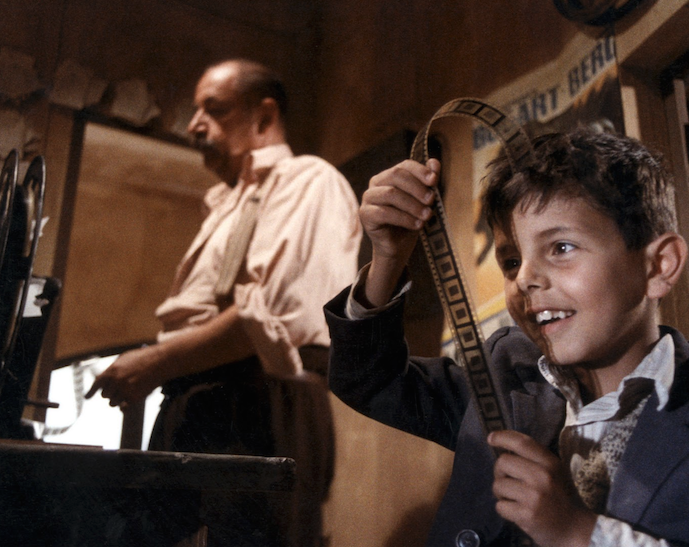Nitrate Film Makes A Comeback
This article originally appeared on Wheeler Winston Dixon’s Frame by Frame blog, dated Tuesday, 26 July 2016
By Wheeler Winston Dixon

A scene from the film “Cinema Paradiso,” which celebrated the beauty of cellulose nitrate 35mm film.
n
As Turner Classic Movies has just announced, the Egyptian Theatre in Hollywood is being retro-fitted with 35mm nitrate projection, an absolute rarity in today’s world, thus giving contemporary audiences a direct view of the shimmering beauty that only nitrate film can provide for viewers.
As the press release notes: “The Film Foundation, the Hollywood Foreign Press Association (HFPA), and Turner Classic Movies (TCM), in conjunction with the American Cinematheque and the Academy Film Archive, today announced a partnership to ensure that the Egyptian Theatre on Hollywood Boulevard in Hollywood has the capability to screen 35mm nitrate film prints. This powerhouse collaboration to retrofit the projection booth will make the Egyptian Theatre one of the few public venues in the country with the ability to project these rare and fragile prints.”
“When I was told that one of the most beautiful movie theaters in the country could be retrofitted for nitrate projection, I was overjoyed, moved, and excited by the potential,” said Martin Scorsese, founder and chair of The Film Foundation. “I hope that this is the beginning of a trend. The art of cinema developed with nitrate from its beginnings to the early ’50s, and the silver content gave us a luminosity and a richness that was never quite matched by the safer stocks that followed or their digital reproductions.
“I’d like to thank all the partners that came together with The Film Foundation — the Hollywood Foreign Press Association, Turner Classic Movies, the Academy Film Archive and the American Cinematheque itself — to make this happen. Needless to say, I’m eager for the completion of the necessary work so that I can see those glorious images projected in that one-of-a-kind theater.”
“As actual film disappears from most of the world’s eyes, we should be screening our existing nitrate prints as much as we safely can,” said Alexander Payne, director and board member of The Film Foundation. “Nothing in theaters or on television today matches the thrill of seeing films on nitrate, and we should take full advantage of our being, sadly, among the last humans able to screen them.”
“The Hollywood Foreign Press Association has long been a supporter of preserving the integrity and history of the art of filmmaking for generations to come,’ said HFPA President Lorenzo Soria. “We are proud to partner with organizations whose values are in line with those of the HFPA, and together we will bring to the historic Egyptian Theatre film the way it was intended to be experienced.”
Cellulose nitrate was the standard film stock in commercial use from the earliest days of cinema until it was discontinued in 1951. Widely agreed to possess a uniquely beautiful image quality, the stock is highly flammable and was replaced by cellulose acetate “safety film.” Nitrate prints, some nearly a century old, still survive in carefully controlled vault environments, but are rarely seen because only a handful of theaters are equipped to screen them.
“Film preservation and the ability to share and celebrate all aspects of film history are central to the mission of TCM,” said Genevieve McGillicuddy, vice president of partnerships and brand activation, TCM. “We’re thrilled to be part of this partnership in order to bring film fans a truly unique opportunity to experience nitrate films.”
American Cinematheque chairman Rick Nicita says, “This exciting project will truly make it possible for the American Cinematheque at the Egyptian Theatre to show every film format possible. A state-of-the-art digital projector will sit side-by-side with our 35mm/70mm machines – representing the rich history of cinema, as well as the future of the art form.”
As someone who has experienced first-hand the intensity and beauty of 35mm nitrate projection – during a visit to the British Film Institute in the late 1990s – I absolutely applaud this decision. Projecting nitrate is certainly not without risk – it’s highly flammable, and needs to be treated with the greatest care during projection and preservation – but for more more than half a century it was the dominant medium for film production, and for quality of image, it simply is in a class by itself.
Sometimes a return to the past is a good thing – this is excellent news!
 Wheeler Winston Dixon, Ryan Professor of Film Studies at the University of Nebraska-Lincoln, is an internationally recognized scholar and writer of film history, theory and criticism. He is the author of 30 books and more than 100 articles on film, and appears regularly in national media outlets discussing film and culture trends. Frame by Frame is a collection of his thoughts on a number of those topics.
Wheeler Winston Dixon, Ryan Professor of Film Studies at the University of Nebraska-Lincoln, is an internationally recognized scholar and writer of film history, theory and criticism. He is the author of 30 books and more than 100 articles on film, and appears regularly in national media outlets discussing film and culture trends. Frame by Frame is a collection of his thoughts on a number of those topics.
Previous Post: The Fight for Rights on The Streets of Greenwood
Next Post: The Mysterious Videos of Bill Domonkos





